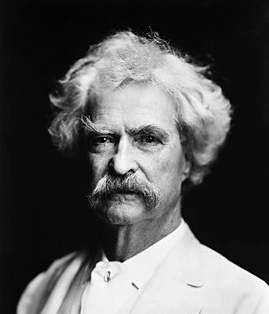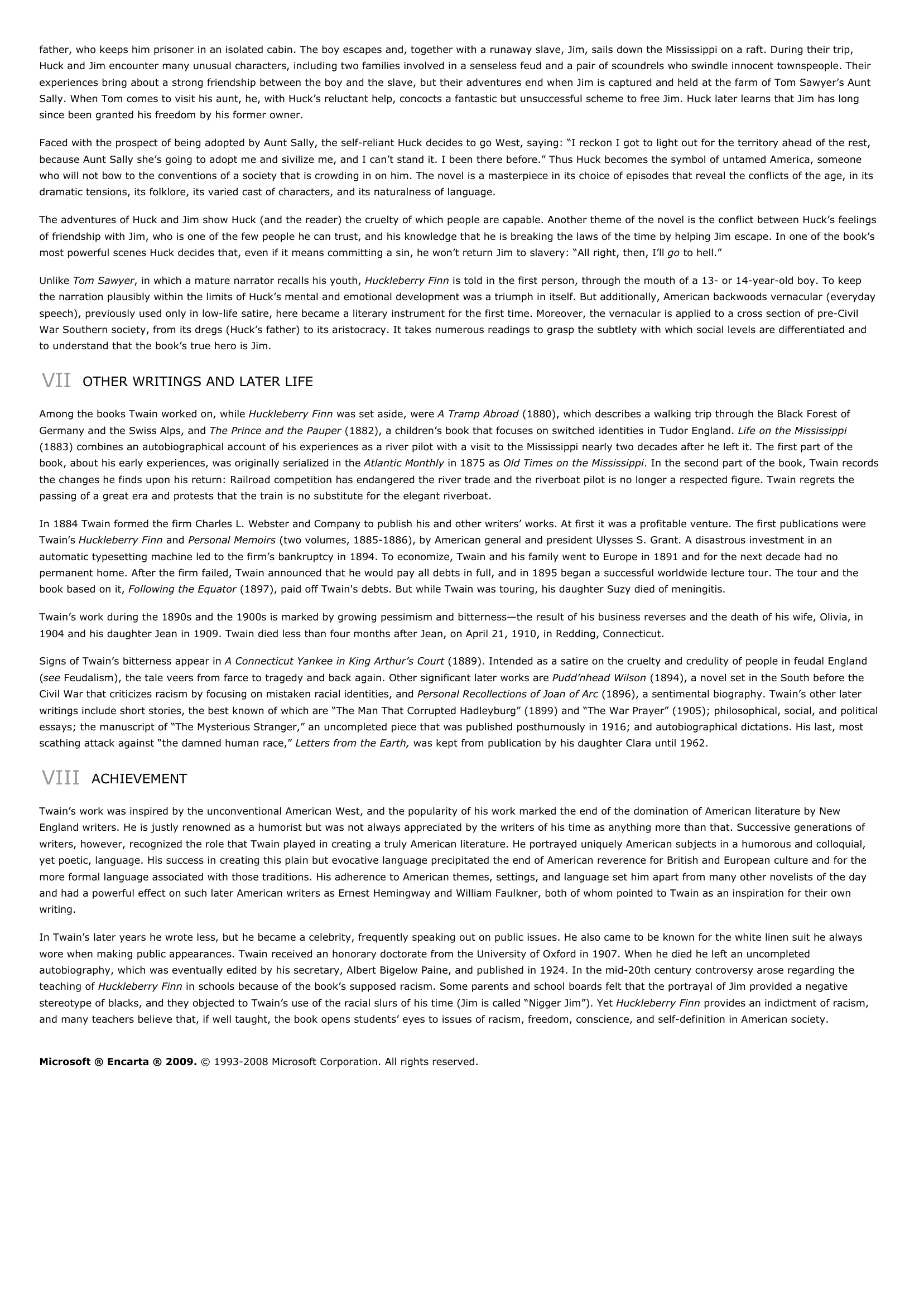Mark Twain I INTRODUCTION Mark Twain, pseudonym of Samuel Langhorne Clemens (1835-1910), American writer and humorist, whose best work is characterized by broad, often irreverent humor or biting social satire.
Publié le 10/05/2013

Extrait du document


«
father, who keeps him prisoner in an isolated cabin.
The boy escapes and, together with a runaway slave, Jim, sails down the Mississippi on a raft.
During their trip,Huck and Jim encounter many unusual characters, including two families involved in a senseless feud and a pair of scoundrels who swindle innocent townspeople.
Theirexperiences bring about a strong friendship between the boy and the slave, but their adventures end when Jim is captured and held at the farm of Tom Sawyer’s AuntSally.
When Tom comes to visit his aunt, he, with Huck’s reluctant help, concocts a fantastic but unsuccessful scheme to free Jim.
Huck later learns that Jim has longsince been granted his freedom by his former owner.
Faced with the prospect of being adopted by Aunt Sally, the self-reliant Huck decides to go West, saying: “I reckon I got to light out for the territory ahead of the rest,because Aunt Sally she’s going to adopt me and sivilize me, and I can’t stand it.
I been there before.” Thus Huck becomes the symbol of untamed America, someonewho will not bow to the conventions of a society that is crowding in on him.
The novel is a masterpiece in its choice of episodes that reveal the conflicts of the age, in itsdramatic tensions, its folklore, its varied cast of characters, and its naturalness of language.
The adventures of Huck and Jim show Huck (and the reader) the cruelty of which people are capable.
Another theme of the novel is the conflict between Huck’s feelingsof friendship with Jim, who is one of the few people he can trust, and his knowledge that he is breaking the laws of the time by helping Jim escape.
In one of the book’smost powerful scenes Huck decides that, even if it means committing a sin, he won’t return Jim to slavery: “All right, then, I’ll go to hell.”
Unlike Tom Sawyer , in which a mature narrator recalls his youth, Huckleberry Finn is told in the first person, through the mouth of a 13- or 14-year-old boy.
To keep the narration plausibly within the limits of Huck’s mental and emotional development was a triumph in itself.
But additionally, American backwoods vernacular (everydayspeech), previously used only in low-life satire, here became a literary instrument for the first time.
Moreover, the vernacular is applied to a cross section of pre-CivilWar Southern society, from its dregs (Huck’s father) to its aristocracy.
It takes numerous readings to grasp the subtlety with which social levels are differentiated andto understand that the book’s true hero is Jim.
VII OTHER WRITINGS AND LATER LIFE
Among the books Twain worked on, while Huckleberry Finn was set aside, were A Tramp Abroad (1880), which describes a walking trip through the Black Forest of Germany and the Swiss Alps, and The Prince and the Pauper (1882), a children’s book that focuses on switched identities in Tudor England.
Life on the Mississippi (1883) combines an autobiographical account of his experiences as a river pilot with a visit to the Mississippi nearly two decades after he left it.
The first part of thebook, about his early experiences, was originally serialized in the Atlantic Monthly in 1875 as Old Times on the Mississippi .
In the second part of the book, Twain records the changes he finds upon his return: Railroad competition has endangered the river trade and the riverboat pilot is no longer a respected figure.
Twain regrets thepassing of a great era and protests that the train is no substitute for the elegant riverboat.
In 1884 Twain formed the firm Charles L.
Webster and Company to publish his and other writers’ works.
At first it was a profitable venture.
The first publications wereTwain’s Huckleberry Finn and Personal Memoirs (two volumes, 1885-1886), by American general and president Ulysses S.
Grant.
A disastrous investment in an automatic typesetting machine led to the firm’s bankruptcy in 1894.
To economize, Twain and his family went to Europe in 1891 and for the next decade had nopermanent home.
After the firm failed, Twain announced that he would pay all debts in full, and in 1895 began a successful worldwide lecture tour.
The tour and thebook based on it, Following the Equator (1897), paid off Twain's debts.
But while Twain was touring, his daughter Suzy died of meningitis.
Twain’s work during the 1890s and the 1900s is marked by growing pessimism and bitterness—the result of his business reverses and the death of his wife, Olivia, in1904 and his daughter Jean in 1909.
Twain died less than four months after Jean, on April 21, 1910, in Redding, Connecticut.
Signs of Twain’s bitterness appear in A Connecticut Yankee in King Arthur’s Court (1889).
Intended as a satire on the cruelty and credulity of people in feudal England (see Feudalism), the tale veers from farce to tragedy and back again.
Other significant later works are Pudd’nhead Wilson (1894), a novel set in the South before the Civil War that criticizes racism by focusing on mistaken racial identities, and Personal Recollections of Joan of Arc (1896), a sentimental biography.
Twain’s other later writings include short stories, the best known of which are “The Man That Corrupted Hadleyburg” (1899) and “The War Prayer” (1905); philosophical, social, and politicalessays; the manuscript of “The Mysterious Stranger,” an uncompleted piece that was published posthumously in 1916; and autobiographical dictations.
His last, mostscathing attack against “the damned human race,” Letters from the Earth, was kept from publication by his daughter Clara until 1962.
VIII ACHIEVEMENT
Twain’s work was inspired by the unconventional American West, and the popularity of his work marked the end of the domination of American literature by NewEngland writers.
He is justly renowned as a humorist but was not always appreciated by the writers of his time as anything more than that.
Successive generations ofwriters, however, recognized the role that Twain played in creating a truly American literature.
He portrayed uniquely American subjects in a humorous and colloquial,yet poetic, language.
His success in creating this plain but evocative language precipitated the end of American reverence for British and European culture and for themore formal language associated with those traditions.
His adherence to American themes, settings, and language set him apart from many other novelists of the dayand had a powerful effect on such later American writers as Ernest Hemingway and William Faulkner, both of whom pointed to Twain as an inspiration for their ownwriting.
In Twain’s later years he wrote less, but he became a celebrity, frequently speaking out on public issues.
He also came to be known for the white linen suit he alwayswore when making public appearances.
Twain received an honorary doctorate from the University of Oxford in 1907.
When he died he left an uncompletedautobiography, which was eventually edited by his secretary, Albert Bigelow Paine, and published in 1924.
In the mid-20th century controversy arose regarding theteaching of Huckleberry Finn in schools because of the book’s supposed racism.
Some parents and school boards felt that the portrayal of Jim provided a negative stereotype of blacks, and they objected to Twain’s use of the racial slurs of his time (Jim is called “Nigger Jim”).
Yet Huckleberry Finn provides an indictment of racism, and many teachers believe that, if well taught, the book opens students’ eyes to issues of racism, freedom, conscience, and self-definition in American society.
Microsoft ® Encarta ® 2009. © 1993-2008 Microsoft Corporation.
All rights reserved..
»
↓↓↓ APERÇU DU DOCUMENT ↓↓↓
Liens utiles
- Mark Twain Extrait de l'autobiographie de Mark Twain (de son vrai nom Samuel Langhorne Clemens) : Dans la généalogie des Clemens de Virginie on trouve une lignée d'ancêtres qui remonte à l'époque de Noé.
- Billy Wilder Billy Wilder (1906-2002), American motion-picture director, writer, and producer, whose best films--usually comedies--employ his distinctive dialogue to elucidate a darkly satirical view of human nature.
- Native American Literature I INTRODUCTION Leslie Marmon Silko Native American writer Leslie Marmon Silko is perhaps best known for her first novel, Ceremony (1977), a coming-of-age story about a young man of mixed Native American and white ancestry.
- Walt Whitman I INTRODUCTION Walt Whitman (1819-1892), American poet, whose work boldly asserts the worth of the individual and the oneness of all humanity.
- Twain (Samuel Langhorne Clemens.












